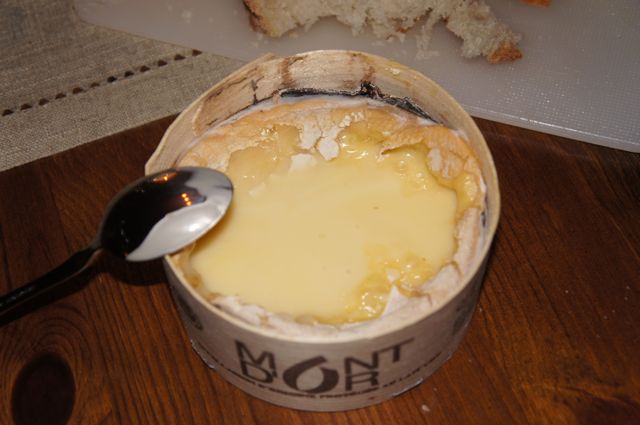
Christmas is over and a new year has just about arisen, so perhaps it’s time for some warm Mont d’Or for some real new year “hygge” in front of the fire place? We have just laid behind us a period where the days became shorter and the darkness sneaked in, but in spite of this a period with a lot of light and expectations. And for some the ultimate stress. Does January represent sort of an anticlimax? Dark, cold and Easter holidays are far ahead. Well, then the “hygge” is all the more important.
From the Jura this cheese, either side of the border between France and Switzerland. I’ve said it before and I do repeat, Mont d’or is just sort of the common noun for this cheese which in France has the proper name of Vacherin du Haut-Doubs and in Switzerland Vacherin Mont d’Or. So a small advantage for the Swiss there. Does not seem like the French version has suffered all that much, though. I prefer the French by the way, and for a particular reason.
I choose French
Not a word against the Swiss, Switzerland or Swiss cheese. They know their cheese even though at first sight they may appear somewhat unvaried with all their alpine cheeses. Which are all excellent, by the way. But behind that facade there are many other interesting cheeses as well. Like the Vacherin Mont d’Or event hough I prefer the French version. For one reason or the other, the Swiss has decided to give the milk a moderate heat treatment, aka thermization. It is still an unpasteurised cheese, but it is not a cheese from raw milk. That’s why I am so careful to pin point that osteperler.no is all about raw milk cheese. That’s what I am devoted to. As natural as possible. And that is why I choose French Mont d’Or.
Why Mont d’Or only during winter?
Well, winter, that’s a relative concept. They can make it from August 15th through till March 15th. Not so much information available about how long they have made Mont d’Or, even though some say they can trace the cheese back to the 12th century or thereabout. Could of course be the tradition with making Mont d’Or goes all that far back, but it’s not for me to speculate. Another highly probable reason is that the summer milk, on the French side of the border was used for making Comté. The farmers formed small cooperatives, also known as fruitières. Making Comté requires considerable amounts of milk, so it sounded like a sensible idea to form cooperatives. They made cheese with long lives helping them through the winters. Getting the milk to these fruitières during wintertime was, however, a risky business. Add that the winter milk is less in volume but richer in milk fat, it seems like a smart decision to make small soft cheeses at the farm. A firm cheese requires less milk fat, as the fat holds on to the liquid and is therefore more suited for soft cheeses. Most alpine cheese and hard cheeses such as Parmigiano Reggiano are made from fat reduced milk. The fat being used for butter and such commodities. I suppose the situation was the same on the Swiss side of the border. However, today both Comté and Gruyère are made all year round, just have to mention that.
To drink
Is it sacrilegious to suggest a glass of fine white? Jura has some wonderful Chardonnays to offer that pairs very well. On the other hand, in Burgundy they drink red Rully or Savigny-les-Beaune. Your choice.
